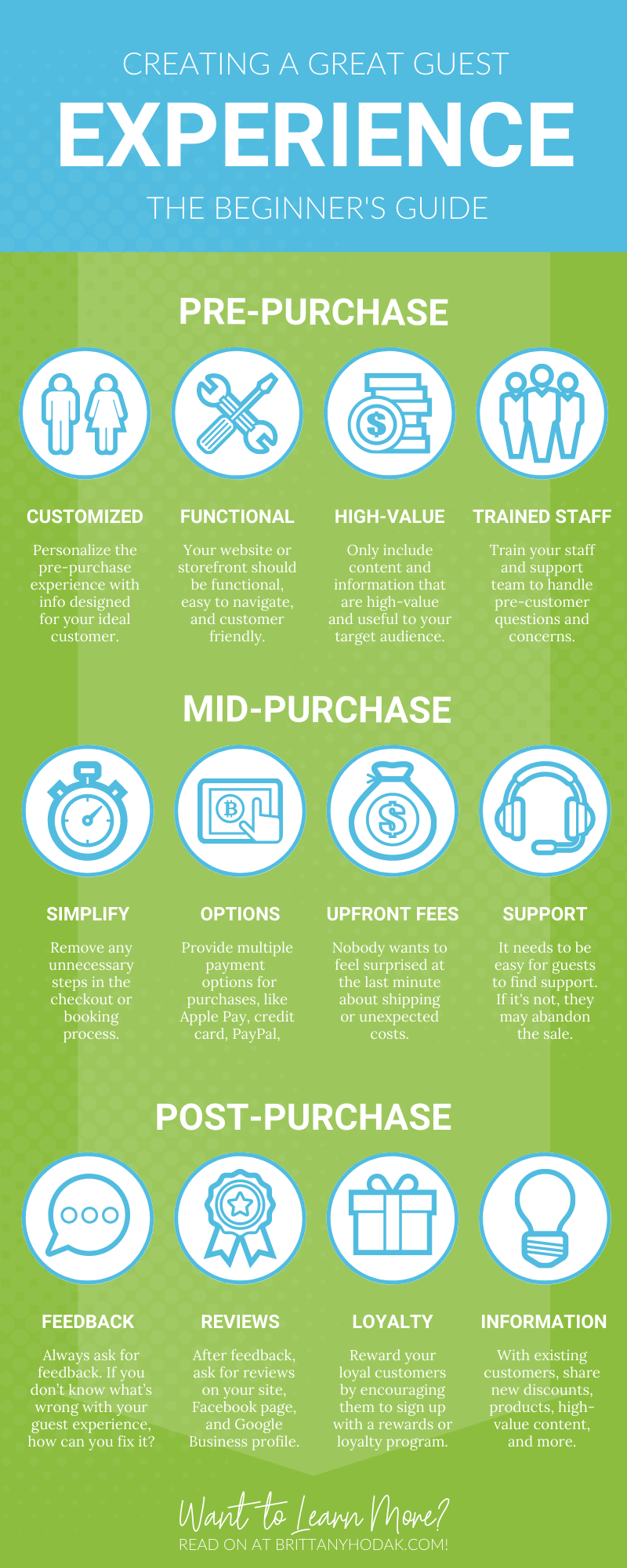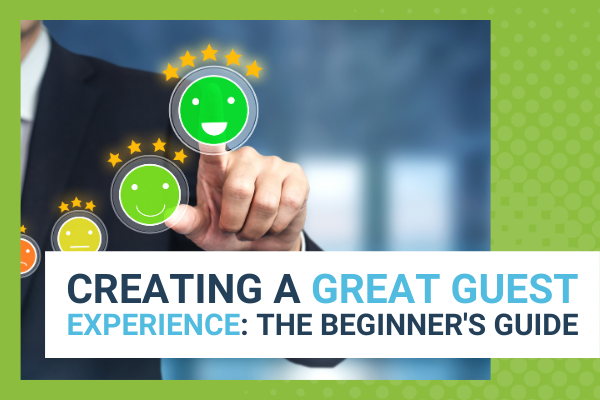While you might think of guest experience as something that only the travel and hospitality industry has to worry about, it’s really a perspective all businesses should consider. Guest experience is essentially the same thing as customer experience, but it’s become a more relevant term in recent years. While traditionally we think of “guests” in terms of hospitality, truly all businesses that work directly with customers have “guests” of their own.
Many business owners confuse guest experience with customer support. While they’re certainly related, you need to look at the bigger picture of guest experience if you want to stand out. A reported 86% of buyers will pay more for a better experience, and this applies to every industry.
Your guest experience is the impression guests have after every interaction with your company. This starts when they’re first learning about your brand and your products/services, and it continues until they make a purchase. An outstanding guest experience creates lasting superfans while a poor guest experience harms your reputation.
How do you get started with your guest experience strategy? It doesn’t matter how long you’ve been in business, it’s time to build this guest experience guide into your customer-first initiative.
Pre-Purchase Guest Experience Tips
First, guest experience breaks into 3 main parts: pre-purchase, mid-purchase, and post-purchase. The pre-purchase refers to how you foster a positive guest experience before the customer hands over any payment information.
When it comes to the pre-purchase experience, you want to make it easy for your guests to learn more about your brand, your products, and why they benefit from choosing you over a competitor. This means using well-written copy to describe your products/services and making sure customer support is easy and available.
For online stores, this also means optimizing your website so it’s easy to navigate and mobile-friendly. A reported 81% of customers research online before they ever make a purchase, so your goal needs to be to make it easy to find photos, reviews, and information. The easier you make this research, the more likely your customers will move to the mid-purchase stage.
On the other hand, for in-person storefronts, keeping your business clean, accessible, and friendly is key for the pre-purchase experience. Ultimately, you want to personalize the pre-purchase experience so your guests feel welcome and invited in. They should feel understood as individuals, not just numbers on a sale’s report.
Next, let’s look at a real-world example of this pre-purchase guest experience in action. Quip is a modern, sleek electric toothbrush that prides itself on making it easy for individuals to take control of their oral health. Their website is easy to navigate, and the product page highlights the toothbrush’s top features in a simple way that even someone with only a basic knowledge of dental hygiene can understand.
From understanding what products individual users need to showing the advantages on one clear page, Quip understands the power of the pre-purchase stage. They use every inch of their website and in-store signage to showcase their competitive advantage over similar products.
Pre-Purchase Checklist:
Now, it’s time to perfect the pre-purchase experience with these checklist items below.
- Personalization: Personalize the pre-purchase experience with information designed for your ideal customer.
- Live or in-person support: Make customer support easy, personal, and accessible, with features like in-person support, live chat, email, and help guides.
- Functionality: Your website or storefront should be functional, easy to navigate, and customer friendly.
- High-value: Only include content, photos, and information that are high-value and useful to your target audience.
- Trained staff: Lastly, train your staff and support team to handle pre-customer questions and concerns.
Mid-Purchase Guest Experience Tips
The mid-purchase guest experience is when your customer is actively making a purchase or booking a service. This could be an in-store purchase, online booking, online sale, and so on. In other words, they’re completing a transaction of some kind.
When focusing on the mid-purchase experience, you want to eliminate friction in the checkout or booking process. Business Insider reports that approximately $4 trillion worth of merchandise is abandoned in incomplete shopping carts each year. This is money that could have been converted into completed sales, but the poor guest experience got in the way.
Again, it’s about making your checkout process as easy to use as possible. Amazon is the retail giant that truly put this into action with their One-Click checkout process (which is patented, by the way). However, brands of all shapes and sizes use this concept to simplify their checkouts.
To see another example, look at the skincare brand Glossier. They make it easy to checkout as a guest, and all of the steps are included on a single page. Not only are the costs clearly explained in the side menu, but there are also multiple payment options so the customers can choose what’s easiest for them. There are no unexpected fees, logins, or time-consuming steps.
Whether you’re encouraging bookings or sales in-person or online, you want the process to be as smooth as possible. This means reducing unnecessary steps, offering multiple payment options, and avoiding added fees that catch the customer off-guard.
Mid-Purchase Checklist:
Next, let’s review the mid-purchase checklist with key takeaways for converting more guests:
- Simplify: Remove any unnecessary steps in the checkout or booking process, like asking users to make an account.
- Multiple payment options: Provide as many payment options for both in-store and online purchases, like Apple Pay, traditional credit card, PayPal, and so on.
- Added fees: Be upfront about any fees. Nobody wants to feel surprised at the last minute about shipping or unexpected costs.
- Support: Finally, it needs to be easy for your guests to get support questions answered quickly. The longer it takes to get help, the more likely they’ll abandon the sale.
Post-Purchase Guest Experience Tips
Finally, let’s fill in the last piece of the puzzle: the post-purchase experience. It’s actually much easier to convince existing customers to make an additional purchase than it is to attract new customers. These are the real goldmine of any business.
It’s all about building relationships that lead to superfans. A superfan is someone who raves about your product and the guest experience, and they’re likely to recommend you to others in their life. Many businesses neglect their customers who already made a purchase because they’ve already completed the initial customer journey.
The business got the sale, so that’s the end of it, right? Wrong.
Instead, the business can encourage the customer to leave a review, provide feedback, or even make another purchase. These small steps not only boost sales, but they convince future guests to make a purchase or booking.
For businesses hoping to get more repeat business, there are so many post-purchase strategies to focus on: implementing a loyalty program, promoting new products, or rewarding top customers with discounts and sales. These small things might not seem impactful, but everyone wants to feel valued as a customer.
An example of a business that excels at the post-purchase experience is Barnes & Noble. This retailer wants customers to continue using them as their go-to bookseller, so they created a special membership to reward engaged guests with discounts, free shipping, and other bonuses.
Though it costs a small fee to join the yearly membership, B&N members save more every time they shop either in-store or online. This means they’re more likely to stay loyal to Barnes & Noble compared to other bookshops.
Post-Purchase Checklist:
It’s time to revolutionize your post-purchase process with these checklist must-dos:
- Feedback: First, always start the post-purchase process with a request for feedback. If you don’t know what’s wrong with your guest experience, how can you fix it?
- Reviews: Then, ask for reviews. Your users aren’t likely to leave them if you don’t ask.
- Loyalty: Reward your loyal customers by encouraging them to sign up with a rewards or loyalty program. These are inexpensive to start, and they ensure your best customers feel special.
- Personalized communications: Finally, continue communicating with your existing customers. Share new discounts, products, high-value content, and more. In other words, keep nurturing this relationship.
Guest Experience: Make Each Interaction Count
While you might associate the guest experience with resorts, theme parks, and spas, every business should treat customers with a hospitality mindset. It’s never been more important to stand out when it comes to your customer interactions, and this starts at the very first pre-purchase stages.
Creating superfans doesn’t happen overnight. You need to understand your customers’ needs, goals, and challenges. From there, you create a guest experience designed with this knowledge in mind. Only then are you prepared to focus on this relationship, nurturing it not just with the first purchase but for a lifetime.






